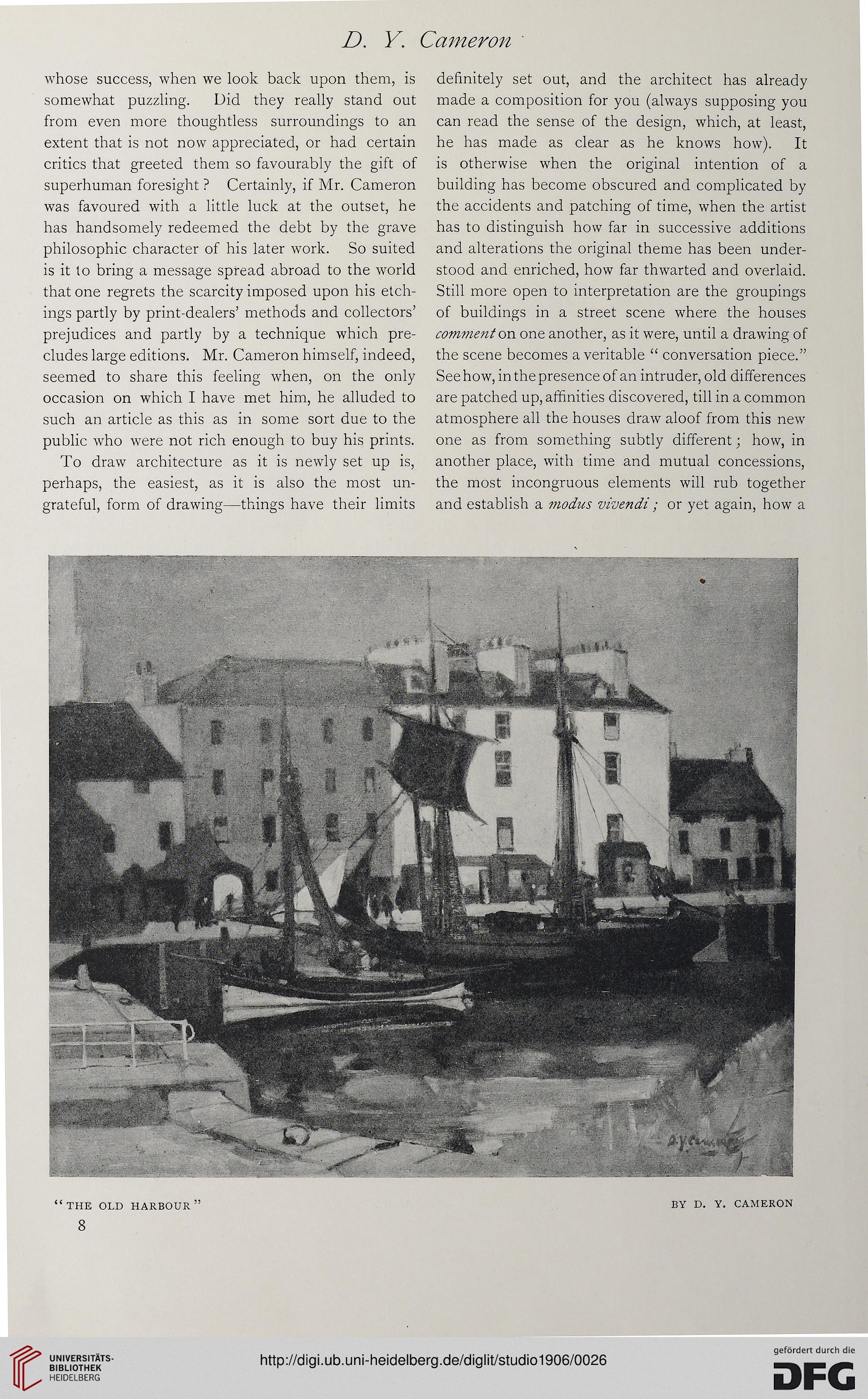D. Y. Cameron
whose success, when we look back upon them, is
somewhat puzzling. Did they really stand out
from even more thoughtless surroundings to an
extent that is not now appreciated, or had certain
critics that greeted them so favourably the gift of
superhuman foresight ? Certainly, if Mr. Cameron
was favoured with a little luck at the outset, he
has handsomely redeemed the debt by the grave
philosophic character of his later work. So suited
is it to bring a message spread abroad to the world
that one regrets the scarcity imposed upon his etch-
ings partly by print-dealers’ methods and collectors’
prejudices and partly by a technique which pre-
cludes large editions. Mr. Cameron himself, indeed,
seemed to share this feeling when, on the only
occasion on which I have met him, he alluded to
such an article as this as in some sort due to the
public who were not rich enough to buy his prints.
To draw architecture as it is newly set up is,
perhaps, the easiest, as it is also the most un-
grateful, form of drawing—things have their limits
definitely set out, and the architect has already
made a composition for you (always supposing you
can read the sense of the design, which, at least,
he has made as clear as he knows how). It
is otherwise when the original intention of a
building has become obscured and complicated by
the accidents and patching of time, when the artist
has to distinguish how far in successive additions
and alterations the original theme has been under-
stood and enriched, how far thwarted and overlaid.
Still more open to interpretation are the groupings
of buildings in a street scene where the houses
comment on one another, as it were, until a drawing of
the scene becomes a veritable “ conversation piece.”
See how, in the presence of an intruder, old differences
are patched up, affinities discovered, till in a common
atmosphere all the houses draw aloof from this new
one as from something subtly different; how, in
another place, with time and mutual concessions,
the most incongruous elements will rub together
and establish a modus vivendi ; or yet again, how a
“the old harbour”
BY D. Y. CAMERON
whose success, when we look back upon them, is
somewhat puzzling. Did they really stand out
from even more thoughtless surroundings to an
extent that is not now appreciated, or had certain
critics that greeted them so favourably the gift of
superhuman foresight ? Certainly, if Mr. Cameron
was favoured with a little luck at the outset, he
has handsomely redeemed the debt by the grave
philosophic character of his later work. So suited
is it to bring a message spread abroad to the world
that one regrets the scarcity imposed upon his etch-
ings partly by print-dealers’ methods and collectors’
prejudices and partly by a technique which pre-
cludes large editions. Mr. Cameron himself, indeed,
seemed to share this feeling when, on the only
occasion on which I have met him, he alluded to
such an article as this as in some sort due to the
public who were not rich enough to buy his prints.
To draw architecture as it is newly set up is,
perhaps, the easiest, as it is also the most un-
grateful, form of drawing—things have their limits
definitely set out, and the architect has already
made a composition for you (always supposing you
can read the sense of the design, which, at least,
he has made as clear as he knows how). It
is otherwise when the original intention of a
building has become obscured and complicated by
the accidents and patching of time, when the artist
has to distinguish how far in successive additions
and alterations the original theme has been under-
stood and enriched, how far thwarted and overlaid.
Still more open to interpretation are the groupings
of buildings in a street scene where the houses
comment on one another, as it were, until a drawing of
the scene becomes a veritable “ conversation piece.”
See how, in the presence of an intruder, old differences
are patched up, affinities discovered, till in a common
atmosphere all the houses draw aloof from this new
one as from something subtly different; how, in
another place, with time and mutual concessions,
the most incongruous elements will rub together
and establish a modus vivendi ; or yet again, how a
“the old harbour”
BY D. Y. CAMERON




